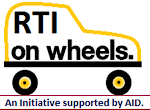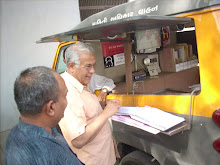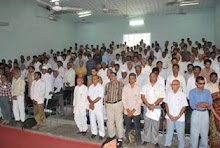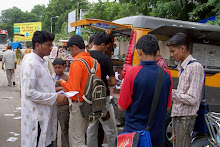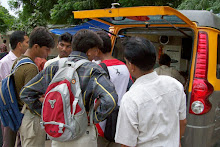The Wire:
New Delhi: Thursday, September 05, 2019.
Readers
may remember the bold declaration that the Union Minister of State for
Personnel, Public Grievances and Pensions made about the NDA II government’s
commitment to transparency while replying to the debate on the Bill to amend
The Right to Information Act, 2005 in the Lok Sabha.
On
July 22, the minister said:
“Now,
coming straight to RTI, as far as RTI is concerned, let me first make it clear
this government has been absolutely committed, as in other wings of governance,
to ensure full transparency and full accountability.”
Sadly,
this philosophy of governance does not seem to have percolated downwards beyond
the corridors of the Prime Minister’s Office (PMO) with which the Union
minister is associated.
In
June, 2019 I had sought detailed information about electronic voting machines
(EVMs), voter verified paper trail (VVPAT) units and symbol loading units
(SLUs), from Bharat Electronics Ltd (BEL) and Electronics Corporation of India
Ltd (ECIL) by filing identical requests under the RTI Act.
When
compared with the ECI’s claims about the maximum capacity of VVPATs to print
votes cast through EVMs and contrasted against the polling station level voter
turnout data as compared with the number of voters registered on the electoral
rolls (all of these are public documents), the nature of the RTI replies throw
open disturbing questions about the entire electoral process.
Background
The
April-May 2019 general elections brought the NDA government to power with a
thumping majority.
Dissatisfied
with the scanty information about the manner in which the polls were conducted
across the country, several private citizens and media persons have used the
RTI Act to seek information about voter turnout data mismatches, complaints
about EVMs malfunctioning, complaints about mismatch of EVMs and VVPAT
printouts, movement of EVMs and VVPATs to the electoral constituencies from the
manufacturing companies and details of action taken on complaints received
against high profile politicians for violating the Model Code of Conduct.
 |
| Several private citizens and media persons have used the RTI Act to seek information about voter turnout data mismatches. : PTI |
Many
of these requests have been turned down by the relevant public authorities.
After
closely scrutinising some of the information and statistics published by the
ECI, on June 17, 2019, I decided to file two identical RTI applications seeking
the information from BEL and ECIL. Neither these companies nor the ECI have
placed this information in the public domain.
BEL’s
replies
The
CPIO of BEL, a navaratna public sector enterprise under the Union Ministry of
Defence, sent a fee intimation letter for INR 1,434 for a total of 717 pages
after almost a month had passed since the submission of my RTI application.
He
agreed to supply most of the information but denied access to the VVPAT patent
application filed with the office of the Controller General of Patents by
citing Section 8(1)(d) of the RTI Act. Then I waited for more than a month for
this information thinking that the delay might be because of the time taken to
copy more than 700 pages of records. After 40 days had passed, on August 28,
2019, I filed a first appeal under Section 19(1) of the RTI Act challenging the
non-supply of information.
Believe
it or not, the CPIO who was silent until then, sent a reply returning the bank
draft and claimed that BEL did not have most of the information which he had
agreed to supply in his first reply.
The
CPIO also rejected one of the queries stating that disclosure would “endanger
the life of its engineers” and returned the bank draft that I sent them as fee
payment.
ECIL’s
reply
Earlier,
ECIL had uploaded some of this information on the online RTI portal but
rejected access to some crucial bits of information I had sought in my RTI
application. I have not received a formal reply from ECIL that has been signed
by its Central Public Information Officer, via email or post till date.
Although
ECIL’s CPIO had disposed of my RTI application earlier, in August, 2019, I
decided to wait for the BEL CPIO’s reply before going public with these RTI
interventions.
What
is problematic with these replies?
BEL’s
CPIO had initially agreed to supply information about the number of EVMs
(control and ballot units), VVPATs manufactured by the company, and the thermal
paper rolls used in the VVPATs which had been sent to the districts for use
during the 2019 Lok Sabha elections. He had also agreed to supply a list of the
names of engineers who took part in and coordinated and supervised the
preparation of these machines for the elections.
He
had physically counted the number of pages relatable to each RTI query and
demanded fees accordingly. In his revised reply, however, he states that BEL
does not hold most of the requested information.
So
which papers did he count before sending the first reply? Only one of these
replies, not both, can be true.
Perhaps
the latest reply is an afterthought arising out of pressure exerted, probably
by an external agency, against making this information public. I hope the
identity of this external agency is revealed during the appeal proceedings in
the coming months.
What
do these replies reveal?
The
total number of votes cast in an assembly or parliamentary constituency is
recorded on Form 20 (called the ‘final result sheet’) by its presiding officer
and submitted to the ECI.
This
information for every constituency, collected in Form 20, has been uploaded on
the ECI’s website for the Lok Sabha elections and state assembly elections up
to 2018. However, similar data is not available for the 2019 Lok Sabha
elections on the ECI’s website.
Any
interested person is now compelled to visit the websites of the chief electoral
officers (CEOs) of every state and Union Territory, separately, to access this
information.
 |
| The polling station-wise data throws up some crucial questions when compared with the ECI’s claims. Photo: PTI |
Even
here, there is no uniformity. While many CEOs have uploaded Part 1 of Form 20
which contains polling station-wise data of the number of votes cast (for
example, see the Delhi CEO’s website), a few have published only Part 2 of Form
20 which contains aggregate data for each assembly segment of a parliamentary
constituency (for example, see Bihar CEO’s website).
It
is, however, the polling station-wise data that throws up some crucial
questions when compared with the ECI’s claims and the RTI replies of BEL and
ECIL. The details of the issues can be found here.
A
credible basis
Two-stage
randomisation of EVMs and VVPATs, once before their allotment to each
constituency and then before sending them to each polling station, is one of
the two pillars on which the ECI, the manufacturing companies and technical
experts rest their arguments for the non-tamperability of these machines.
If
the capacities of the VVPATs produced by BEL and ECIL vary, can there ever be a
true randomisation, given the lack of uniformity in the number of voters
registered for each polling station?
This
is a seminal question that the ECI as the owner of the EVMs and VVPATs must
answer urgently.
I
would like to end this piece with a caveat. I am not alleging any wrongdoing by
any authority through this research and analysis. All that I am pointing out is
that the ECI and the manufacturing companies are reluctant to place detailed
information about the working of EVMs and VVPATs beyond what they decide that
the citizenry must know. This is just not acceptable.
(Venkatesh
Nayak is programme head of the Access to Information Programme of the
Commonwealth Human Rights Initiative.)





